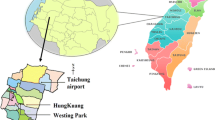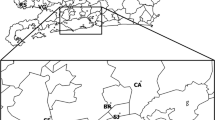Abstract
Ambient air and coarse, fine and particulate-bound mercury (Hg(p)) pollutants were collected and analyzed from March 17 to May 22 and September 3, 2009 to March 5, 2010 at a highway traffic site located in Sha-Lu, central Taiwan. This study has the following objectives: (1) to measure the coarse and fine particulates concentrations and the particulate-bound mercury Hg(p) which was attached to these particulate; (2) to determine the average Hg(p) compositions in coarse and fine particulates and (3) to compare the Hg(p) concentrations and compositions particulate in this study to the those obtained in other studies. The results obtained in this study indicated that the average ambient air PM2.5, PM2.5–10 and PM10 were 18.79 ± 6.71, 11.22 ± 4.93 and 30.01 ± 10.27 μg/m3, respectively. The ranges of concentrations for Hg(p) in PM2.5 were from 0.0016 to 0.0557 ng/m3, from 0.0006 to 0.0364 ng/m3 in PM2.5–10 and from 0.0022 to 0.0862 ng/m3 in PM10. In addition, the highest particle-bound mercury compositions in PM2.5 were 16.85 ng/g and the lowest particle-bound mercury concentrations were 0.55 ng/g. The highest particle-bound mercury compositions in PM2.5–10 were 13.88 ng/g and the lowest particle-bound mercury in PM2.5–10 were 0.22 ng/g.



Similar content being viewed by others
References
Agency for Toxic Substances and Disease Registry (ATSDR) (1999a) Toxicological profile for Mercury. http://www.atsdr.cdc.gov/toxprofiles/tp46.html
Agency for Toxic Substances and Disease Registry (ATSDR) (1999b) Toxicological profile for mercury. http://www.atsdr.cdc.gov/toxprofiles/tp46.html
Ames M, Gullu G, Olmez I (1998) Atmospheric mercury in the vapor phase, and in fine and coarse particulate matter at Perch River, New York. Atmos Environ 32:865–872
Basu N, Scheuhammer AM, Sonne C, Letcher RJ, Born EW, Dietz R (2009) Is dietary mercury of neurotoxicological concern to wild polar bears. Environ Toxicol Chem 28:133–140
Cheng T, Lu D, Wang G, Xu Y (2005) Chemical characteristics of Asian dust aerosol from Hunshan Dake Sandland in Northern China. Atmos Environ 39:2903–2911
Diociaiuti M, Balduzzi M, Berardis BD, Cattani G, Stacchini G, Ziemacki G, Marconi A, Paoletti L (2001) The two PM2.5 (fine) and PM2.5–10 (coarse) fractions: evidence of different biological activity. Environ Res 86:254–262
Environmental Health Hazard Assessment, California EPA (CalEPA) (2005) http://www.oehha.ca.gov/air/chronic_rels/AllChrels.html
Fang GC, Wu YS, Lee WJ, Chou TY, Lin IC (2007) Study of ambient air particulates pollutants near Taichung airport sampling site in central Taiwan. Atmos Res 144:492–498
Fang GC, Basu N, Nam DH, Yang IL (2009) Characterization of ambient air particulates and particulate mercury at Sha-Lu, central Taiwan. Environ Forensic 10(4):277–285
Gabriel MC, Williamson DG, Brooks S, Lindberg S (2005) Atmospheric speciation of mercury in two contrasting Southeastern US air sheds. Atmos Environ 39:4947–4958
Hall B (1995) The gas phase oxidation of elemental mercury by ozone. Water Air Soil Pollut 80:301–315
Hien PD, Binh NT, Truong Y, Ngo NT, Sieu LN (2001) Comparative receptor modeling study of TSP, PM2 and PM2–10 in Ho Chi Minh City. Atmos Environ 35:2669–2678
Kim KH, Kim MY, Kim J, Lee G (2002) The concentrations and fluxes of total gaseous mercury in a western coastal area of Korea during late March 2001. Atmos Environ 36:3413–3427
Kim KH, Kim MY, Hong SM, Youn YH, Hwang JE (2005) The effects of wind speed on the relative relationships between different sized-fractions of airborne particles. Chemosphere 59:929–937
Lai SO, Holsen TM, Han YJ, Hopke PP, Yi SM, Blanchard P, Pagano JJ, Milligan M (2007) Estimation of mercury loadings to Lake Ontario: results from the Lake Ontario atmospheric deposition study (LOADS). Atmos Environ 41:8205–8218
Lamborg CH, Fitzgerald WF, Vandal GM, Rolfhus KR (1995) Atmospheric mercury in northern Wisconsin: sources and species. Water Air Soil Pollut 80:189–198
Landis MS, Keeler GJ (2002) Atmospheric mercury deposition to Lake Michigan during the Lake Michigan Mass balance study. Environ Sci Technol 36:4518–4524
Landis M, Vette AF, Keeler GJ (2002) Atmospheric mercury in the Lake Michigan basin: influence of the Chicago/Gary urban area. Crit Rev Environ Sci Technol 36:4508–4517
Landis M, Keeler GJ, Al-Wali KI, Stevens RK (2004) Divalent inorganic reactive gaseous mercury emissions from a mercury cell chlor-alkali plant and its impact on near-field atmospheric dry deposition. Atmos Environ 38:613–622
Lau OW, Luk SF (2001) Leaves of Bauhinia blakeana as indicators of atmospheric pollution in Hong Kong. Atmos Environ 35:3113–3120
Lindberg SE, Stratton WJ (1998) Atmospheric mercury speciation: concentrations and behavior of reactive gaseous mercury in ambient air. Crit Rev Environ Sci Technol 32:49–57
Lindberg SE, Stratton WJ, Pai P, Allan MA (2000) Measurements and modeling of a water soluble gas-phase mercury species in ambient air. Fuel Process Technol 65–66:143–156
Lindberg SE, Brooks S, Lin CJ, Scott KJ, Landis MS, Stevens RK, Goodsite M, Richter A (2002) Dynamic oxidation of gaseous mercury in the Arctic troposphere at polar sunrise. Crit Rev Environ Sci Technol 36:1245–1256
Lindqvist O, Rodhe H (1985) Atmospheric mercury—a review. Tellus 37B:136–159
Liu S, Nadim F, Perkins C, Carley RJ, Hoag GE, Lin Y, Chen L (2002) Atmospheric mercury monitoring survey in Beijing, China. Chemosphere 48:97–107
Lonati G, Ozgen S, Giugliano M (2007) Primary and secondary carbonaceous species in PMPM2.5 samples in Milan (Italy). Atmos Environ 41:4599–4610
Maenhaut W, De Ridder DJA, Fernandez-Jimenez MT, Hooper MA, Hooper B, Nurhayati M (2002) Long-tern observations of regional aerosol composition at two sites in Indonesia. Nucl Instrum Meth B 189:259–265
Marins RV, Andrade JB, Pereira PAP, Paiva EC, Paraquetti HM (2000) Sampling techniques for the assessment of anthropogenic vapour and particulate mercury in the Brazilian Amazon atmosphere. J Environ Monitor 2:325–328
Marsik FJ, Keeler GJ, Landis MS (2007) The dry-deposition of speciated mercury to the Florida Everglades: measurements and modeling. Atmos Environ 41:136–149
Mason RP, Fitzgerald WF, Morel FM (1994) The biogeochemical cycling of elemental mercury: anthropogenic influences. Geochim Cosmochim Acta 58:3191–3198
Mason RP, Lawson NM, Sullivan KA (1997) Atmospheric deposition to the Chesapeake Bay watershed—regional and local sources. Atmos Environ 31:3531–3540
Munthe J (1992) The aqueous oxidation of elemental mercury by ozone. Atmos Environ 26A:1461–1468
Olmez I, Ames MR, Gullu G (1998) Canadian and U.S. sources impacting the mercury levels in fine atmospheric particulate material across New York State. Crit Rev Environ Sci Technol 2:3048–3054
Pope CA, Thun MJ, Namboodira M, Dockery DW, Evans JS, Speizer FE, Health CW Jr (1995) Particulate air pollution as a predictor of mortality in a prospective study of US adults. Am J Respir Crit Care Med 151:669–674
Sakata M, Marumoto K (2002) Formation of atmospheric particulate mercury in the Tokyo metropolitan area. Atmos Environ 36:239–246
Schroeder WH, Munthe J (1998) Atmospheric mercury—an overview. Atmos Environ 32:809–822
Schroeder WH, Yarwood G, Niki H (1991) Transformation processes involving mercury species in the atmosphere: results from a literature survey. Water Air Soil Pollut 56:653–666
Schwartz J (1994) Air pollution and daily mortality: a review and metaanalysis. Environ Res 64:36–52
Shwartz J, Dockery DW, Neas LM (1996) Is daily mortality associated specifically with fine particles? J Air Waste Manage Assoc 46:927–939
Slemr F, Schuster G, Seiler W (1985) Distribution, speciation, and budget of atmospheric mercury. J Atmos Chem. 3:407–434
Song Y, Tang X, Xie S, Zhang Y, Wei Y, Zhang M, Zeng L, Lu S (2007) Source apportionment of PM2.5 in Beijing in 2004. J Hazard Mater 146:124–130
Stratton WJ, Lindberg SE, Perry CJ (2001) Atmospheric mercury speciation: laboratory and field evaluation of a mist chamber method for measuring reactive gaseous mercury. Crit Rev Environ Sci Technol 35:170–177
Temme C, Einax JW, Ebinghaus R, Schroeder W (2003a) Measurements of atmospheric mercury species at a coastal site in the Antarctic and over the South Atlantic Ocean during Polar Summer. Crit Rev Environ Sci Technol 37:22–31
Temme C, Slemr F, Ebinghaus R, Einax JW (2003b) Distribution of mercury over the Atlantic Ocean in 1996 and 1999–2001. Atmos Environ 37:1889–1897
Tsai YI, Kuo SC, Lin YH (2003) Temporal characteristics of inhalable mercury and arsenic aerosols in the urban atmosphere in southern Taiwan. Atmos Environ 37:3401–3411
United States Environmental Protection Agency (US EPA) (2007) Mercury, elemental (CASRN 7439-97-6). Integrated Risk Information System (IRIS). US EPA, Office of Research and Development, National Center for Environmental Assessment, Washington, DC. http://www.epa.gov/iris/subst/0370.htm. Accessed 10 July 2008
World Health Organization (WHO) (2000) Air quality guidelines for Europe, 2nd edn. WHO Regional Publications, European Series, No. 91. ISBN 92-890-1358-3
Acknowledgments
The authors would like to thank the National Science Council of the Republic of China, Taiwan, for financially supporting this research under Contract No. NSC 96-2628-E-241-001-MY3.
Author information
Authors and Affiliations
Corresponding author
Rights and permissions
About this article
Cite this article
Fang, GC., Yang, IL. & Liu, CK. Coarse and fine particulates, Hg(p)-bound particulate concentrations and compositions study at Sha-Lu, central Taiwan. Environ Earth Sci 63, 263–271 (2011). https://doi.org/10.1007/s12665-010-0698-9
Received:
Accepted:
Published:
Issue Date:
DOI: https://doi.org/10.1007/s12665-010-0698-9




